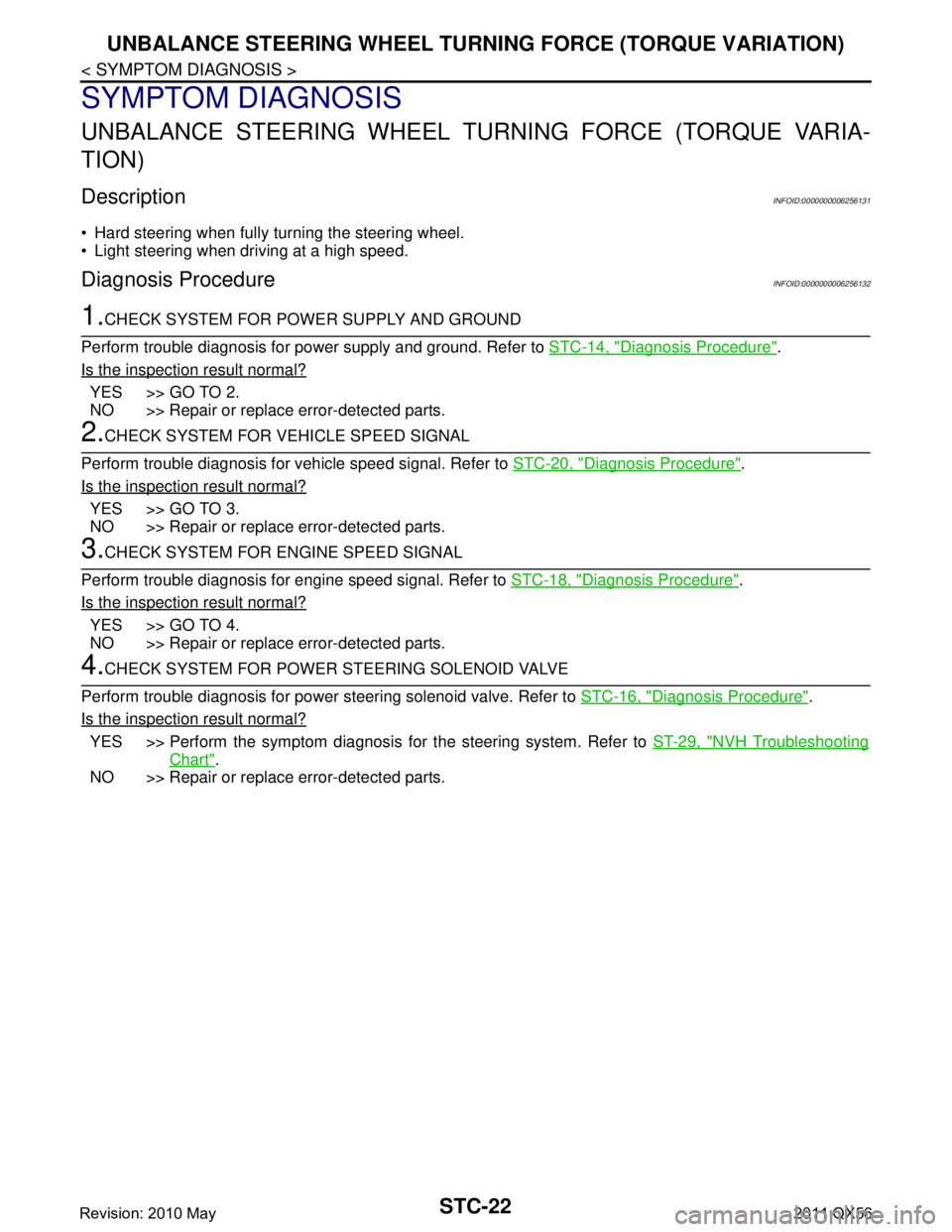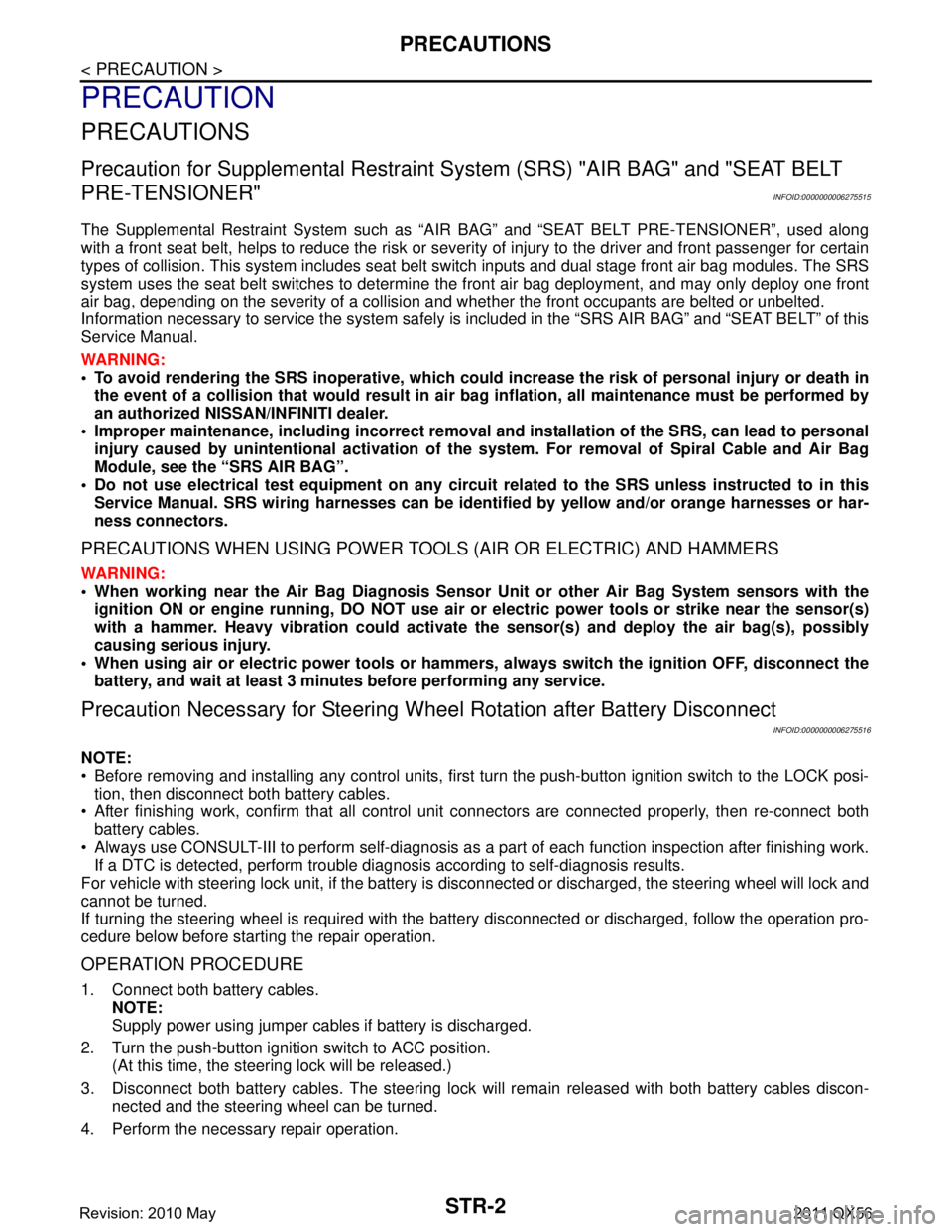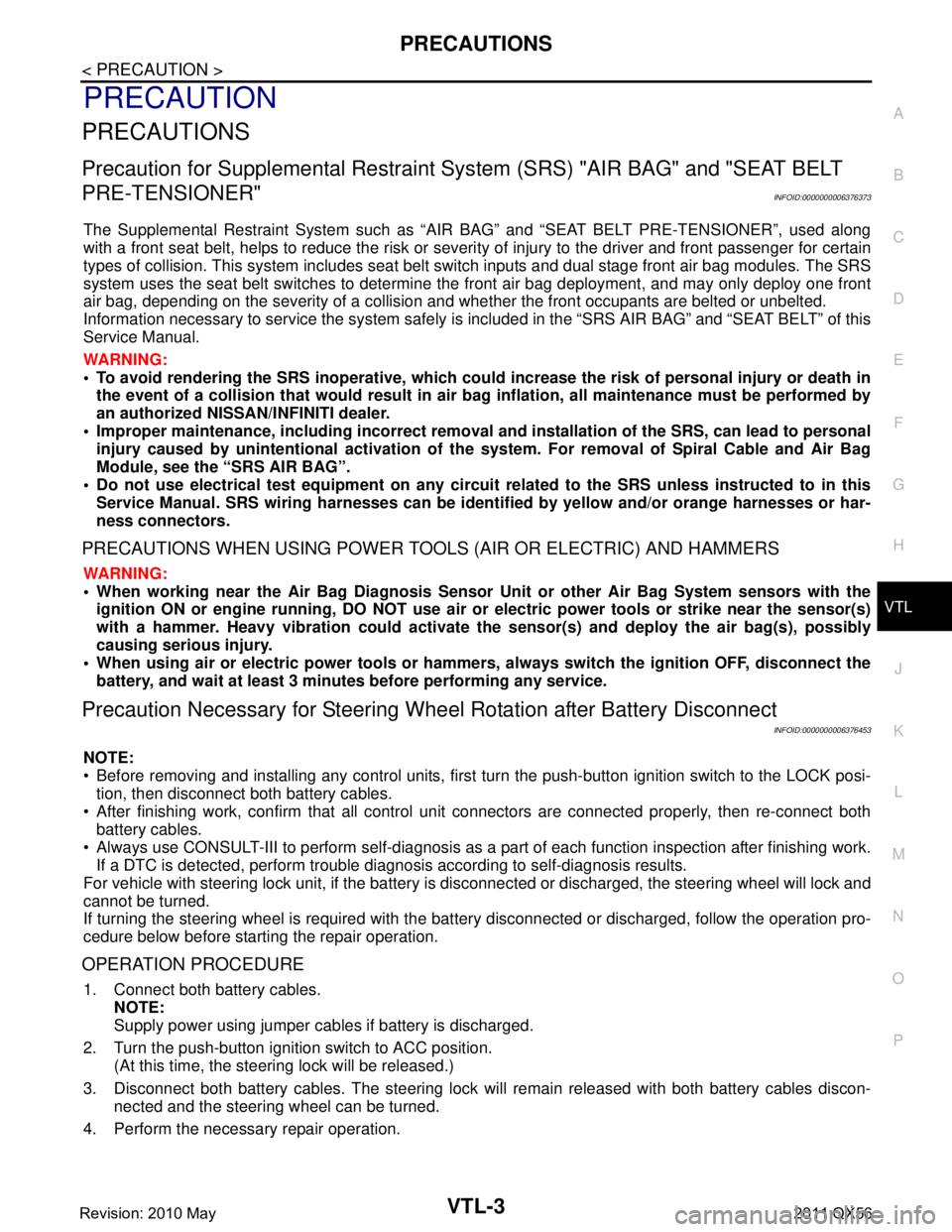2011 INFINITI QX56 wheel
[x] Cancel search: wheelPage 5067 of 5598

STC-22
< SYMPTOM DIAGNOSIS >
UNBALANCE STEERING WHEEL TURNING FORCE (TORQUE VARIATION)
SYMPTOM DIAGNOSIS
UNBALANCE STEERING WHEEL TURNING FORCE (TORQUE VARIA-
TION)
Description INFOID:0000000006256131
Hard steering when fully turning the steering wheel.
Light steering when driving at a high speed.
Diagnosis Procedure INFOID:0000000006256132
1.CHECK SYSTEM FOR POWER SUPPLY AND GROUND
Perform trouble diagnosis for power supply and ground. Refer to STC-14, "
Diagnosis Procedure".
Is the inspection result normal?
YES >> GO TO 2.
NO >> Repair or replace error-detected parts.
2.CHECK SYSTEM FOR VEHICLE SPEED SIGNAL
Perform trouble diagnosis for vehicle speed signal. Refer to STC-20, "
Diagnosis Procedure".
Is the inspection result normal?
YES >> GO TO 3.
NO >> Repair or replace error-detected parts.
3.CHECK SYSTEM FOR ENGINE SPEED SIGNAL
Perform trouble diagnosis for engine speed signal. Refer to STC-18, "
Diagnosis Procedure".
Is the inspection result normal?
YES >> GO TO 4.
NO >> Repair or replace error-detected parts.
4.CHECK SYSTEM FOR POWER STEERING SOLENOID VALVE
Perform trouble diagnosis for power steering solenoid valve. Refer to STC-16, "
Diagnosis Procedure".
Is the inspection result normal?
YES >> Perform the symptom diagnosis for the steering system. Refer to ST-29, "NVH Troubleshooting
Chart".
NO >> Repair or replace error-detected parts.
Revision: 2010 May2011 QX56
Page 5069 of 5598

STR-1
ENGINE
C
DE
F
G H
I
J
K L
M
SECTION STR
A
STR
N
O P
CONTENTS
STARTING SYSTEM
PRECAUTION ................ ...............................2
PRECAUTIONS .............................................. .....2
Precaution for Supplemental Restraint System
(SRS) "AIR BAG" and "SEAT BELT PRE-TEN-
SIONER" ............................................................. ......
2
Precaution Necessary for Steering Wheel Rota-
tion after Battery Disconnect .....................................
2
PREPARATION ............................................4
PREPARATION .............................................. .....4
Special Service Tools .......................................... ......4
Commercial Service Tools ........................................4
SYSTEM DESCRIPTION ..............................5
COMPONENT PARTS ................................... .....5
Component Parts Location .................................. ......5
Component Description ............................................5
SYSTEM ..............................................................6
System Diagram .................................................. ......6
System Description ...................................................6
WIRING DIAGRAM .......................................7
STARTING SYSTEM ...................................... .....7
Wiring Diagram ................................................... ......7
BASIC INSPECTION ...................................11
DIAGNOSIS AND REPAIR WORKFLOW ........11
Work Flow ............................................................ ....11
DTC/CIRCUIT DIAGNOSIS .........................14
B TERMINAL CIRCUIT .....................................14
Diagnosis Procedure ........................................... ....14
S CONNECTOR CIRCUIT .................................15
Diagnosis Procedure ...............................................15
SYMPTOM DIAGNOSIS ..............................16
STARTING SYSTEM .........................................16
Symptom Table ................................................... ....16
REMOVAL AND INSTALLATION ...............17
STARTER MOTOR ...........................................17
Exploded View ..................................................... ....17
Removal and Installation .........................................18
Inspection ................................................................18
SERVICE DATA AND SPECIFICATIONS
(SDS) ............... .............................................
20
SERVICE DATA AND SPECIFICATIONS
(SDS) .................................................................
20
Starter Motor .......................................................
Revision: 2010 May2011 QX56
Page 5070 of 5598

STR-2
< PRECAUTION >
PRECAUTIONS
PRECAUTION
PRECAUTIONS
Precaution for Supplemental Restraint System (SRS) "AIR BAG" and "SEAT BELT
PRE-TENSIONER"
INFOID:0000000006275515
The Supplemental Restraint System such as “A IR BAG” and “SEAT BELT PRE-TENSIONER”, used along
with a front seat belt, helps to reduce the risk or severi ty of injury to the driver and front passenger for certain
types of collision. This system includes seat belt switch inputs and dual stage front air bag modules. The SRS
system uses the seat belt switches to determine the front air bag deployment, and may only deploy one front
air bag, depending on the severity of a collision and w hether the front occupants are belted or unbelted.
Information necessary to service the system safely is included in the “SRS AIR BAG” and “SEAT BELT” of this
Service Manual.
WARNING:
• To avoid rendering the SRS inopera tive, which could increase the risk of personal injury or death in
the event of a collision that would result in air bag inflation, all maintenance must be performed by
an authorized NISS AN/INFINITI dealer.
Improper maintenance, including in correct removal and installation of the SRS, can lead to personal
injury caused by unintent ional activation of the system. For re moval of Spiral Cable and Air Bag
Module, see the “SRS AIR BAG”.
Do not use electrical test equipmen t on any circuit related to the SRS unless instructed to in this
Service Manual. SRS wiring harnesses can be identi fied by yellow and/or orange harnesses or har-
ness connectors.
PRECAUTIONS WHEN USING POWER TOOLS (AIR OR ELECTRIC) AND HAMMERS
WARNING:
When working near the Air Bag Diagnosis Sensor Unit or other Air Bag System sensors with the ignition ON or engine running, DO NOT use air or electric power tools or strike near the sensor(s)
with a hammer. Heavy vibration could activate the sensor(s) and deploy the air bag(s), possibly
causing serious injury.
When using air or electric power tools or hammers , always switch the ignition OFF, disconnect the
battery, and wait at least 3 minu tes before performing any service.
Precaution Necessary for Steering W heel Rotation after Battery Disconnect
INFOID:0000000006275516
NOTE:
Before removing and installing any control units, first tu rn the push-button ignition switch to the LOCK posi-
tion, then disconnect bot h battery cables.
After finishing work, confirm that all control unit connectors are connected properly, then re-connect both
battery cables.
Always use CONSULT-III to perform self-diagnosis as a part of each function inspection after finishing work.
If a DTC is detected, perform trouble diagnos is according to self-diagnosis results.
For vehicle with steering lock unit, if the battery is disconnected or discharged, the steering wheel will lock and
cannot be turned.
If turning the steering wheel is required with the bat tery disconnected or discharged, follow the operation pro-
cedure below before starting the repair operation.
OPERATION PROCEDURE
1. Connect both battery cables. NOTE:
Supply power using jumper cables if battery is discharged.
2. Turn the push-button ignition switch to ACC position. (At this time, the steering lock will be released.)
3. Disconnect both battery cables. The steering lock wi ll remain released with both battery cables discon-
nected and the steering wheel can be turned.
4. Perform the necessary repair operation.
Revision: 2010 May2011 QX56
Page 5071 of 5598

PRECAUTIONSSTR-3
< PRECAUTION >
C
DE
F
G H
I
J
K L
M A
STR
NP
O
5. When the repair work is completed, re-connect both
battery cables. With the brake pedal released, turn
the push-button ignition switch from ACC position to ON position, then to LOCK position. (The steering
wheel will lock when the push-button ignition switch is turned to LOCK position.)
6. Perform self-diagnosis check of a ll control units using CONSULT-III.
Revision: 2010 May2011 QX56
Page 5133 of 5598
![INFINITI QX56 2011 Factory Service Manual
SYSTEMTM-45
< SYSTEM DESCRIPTION > [7AT: RE7R01B]
C
EF
G H
I
J
K L
M A
B
TM
N
O P
Transmit required output signals to the respective solenoids.
A/T CONTROL SYSTEM : Fail-SafeINFOID:0000000006226769 INFINITI QX56 2011 Factory Service Manual
SYSTEMTM-45
< SYSTEM DESCRIPTION > [7AT: RE7R01B]
C
EF
G H
I
J
K L
M A
B
TM
N
O P
Transmit required output signals to the respective solenoids.
A/T CONTROL SYSTEM : Fail-SafeINFOID:0000000006226769](/manual-img/42/57033/w960_57033-5132.png)
SYSTEMTM-45
< SYSTEM DESCRIPTION > [7AT: RE7R01B]
C
EF
G H
I
J
K L
M A
B
TM
N
O P
Transmit required output signals to the respective solenoids.
A/T CONTROL SYSTEM : Fail-SafeINFOID:0000000006226769
TCM has the electrical fail-safe mode. The mode is divi ded into a maximum of 3 phases (1st fail-safe, 2nd fail-
safe and final fail-safe) and functions so that the operat ion can be continued even if the signal circuit of the
main electronically controlled input/output parts is damaged.
Even if the electronic circuit is normal, the fail-safe mode may start under special conditions (such as when the
brake pedal is depressed suddenly from a hard wheel spin st atus to stop the rotation of wheels). In this case,
turn the ignition switch OFF and back to ON after 5 seconds to resume the normal shift pattern.
Consequently, the customer's vehicle may already return to the normal condition. Refer to TM-88, "
Diagnosis
Flow".
FAIL-SAFE FUNCTION
1st Fail-SafeThe mode that the vehicle can stop safely, to prompt the driver to stop if the malfunction occurs and to shift to
2nd fail-safe early. It shifts to 2nd fail-safe or final fail-safe after the vehicle stopped.
2nd Fail-Safe The mode that the vehicle shifts to final fail-safe without changing the behavior, by identifying the malfunction-
ing parts in the condition that the driving force required for the driving is secured.
Final Fail-Safe Selects the shifting pattern that the malfunctioning parts identified at 1st fail-safe and 2nd fail-safe are not
used, and then secure the driving force that is required for the driving.
The mode that the shifting performance does not decrease by normal shift control.
DTC Veh ic le
condition Vehicle behavior for 1st fail-safe Vehicle behavior for 2nd fail-safe Vehicle behavior for final fail-safe
P0615 — Starter is disabled — Starter is disabled
P0705 — Fixed in the “D” position (The
shifting can be performed)
30 km/h (19MPH) or less
Lock-up is prohibited
The shifting between the gears of 3 - 4 - 5 - 6 - 7 can be per-
formed
Manual mode is prohibited
Shift position indicator is switched OFF
Starter relay is switched OFF (starter is disabled)
Back-up lamp is OFF
Large shift shock — Fixed in the “D” position (The
shifting can be performed)
30 km/h (19 MPH) or less
Lock-up is prohibited
The shifting between the gears of 3 - 4 - 5 - 6 - 7 can be per-
formed
Manual mode is prohibited
Shift position indicator is switched OFF
Starter relay is switched OFF (starter is disabled)
Back-up lamp is OFF
Large shift shock
P0710 Between
the gears of 1 - 2 - 3 The shifting between the gears
of 1 - 2 - 3 can be performed
Manual mode is prohibited —
The shifting between the gears
of 1 - 2 - 3 can be performed
Manual mode is prohibited
Between
the gears of 4 - 5 - 6 - 7 Fix the gear while driving
Manual mode is prohibited
—
P0717 Between
the gears of
1 - 2 - 3 The shifting between the gears
of 1 - 2 - 3 can be performed
Manual mode is prohibited —
The shifting between the gears
of 1 - 2 - 3 can be performed
Manual mode is prohibited
Between
the gears of 4 - 5 - 6 - 7 Fix the gear while driving
Manual mode is prohibited
—
Revision: 2010 May2011 QX56
Page 5162 of 5598
![INFINITI QX56 2011 Factory Service Manual
TM-74
< ECU DIAGNOSIS INFORMATION >[7AT: RE7R01B]
TCM
Fail-Safe
INFOID:0000000006226783
TCM has the electrical fail-safe mode. The mode is divi ded into a maximum of 3 phases (1st fail-safe, 2nd fail INFINITI QX56 2011 Factory Service Manual
TM-74
< ECU DIAGNOSIS INFORMATION >[7AT: RE7R01B]
TCM
Fail-Safe
INFOID:0000000006226783
TCM has the electrical fail-safe mode. The mode is divi ded into a maximum of 3 phases (1st fail-safe, 2nd fail](/manual-img/42/57033/w960_57033-5161.png)
TM-74
< ECU DIAGNOSIS INFORMATION >[7AT: RE7R01B]
TCM
Fail-Safe
INFOID:0000000006226783
TCM has the electrical fail-safe mode. The mode is divi ded into a maximum of 3 phases (1st fail-safe, 2nd fail-
safe and final fail-safe) and functions so that the operat ion can be continued even if the signal circuit of the
main electronically controll ed input/output parts is damaged.
Even if the electronic circuit is normal, the fail-safe mode may start under special conditions (such as when the
brake pedal is depressed suddenly from a hard wheel spin status to stop the rotation of wheels). In this case,
turn the ignition switch OFF and back to ON after 5 seconds to resume the normal shift pattern.
Consequently, the customer's vehicle may already return to the normal condition. Refer to TM-88, "
Diagnosis
Flow".
FAIL-SAFE FUNCTION
3
(L) —CAN-H
Input/
Output ——
4
(SB) —K-line Input/
Output ——
5
(B) Ground Ground Output Always 0 V
6
(V) Ground Power supply Input Ignition switch ON Battery voltage
Ignition switch OFF 0 V
7
(R) Ground Back-up lamp relay Input Ignition switch ON Selector lever in
“R” position. 0 V
Selector lever in other than
above. Battery voltage
8
(P) —CAN-L Input/
Output ——
9
(BR) Ground Starter relay Output Ignition switch ON Selector lever in “N” and “P” po-
sitions.
Battery voltage
Selector lever in other than
above. 0 V
10
(B) Ground Ground Output Always 0 V
Te r m i n a l
(Wire color) Description
Condition Value (Approx.)
+ −Signal name Input/
Output
1st Fail-Safe The mode that the vehicle can stop safely, to prompt the driver to stop if the malfunction occurs and to shift to
2nd fail-safe early. It shifts to 2nd fail-safe or final fail-safe after the vehicle stopped.
2nd Fail-Safe The mode that the vehicle shifts to final fail-safe without changing the behavior, by identifying the malfunction-
ing parts in the condition that the driving force required for the driving is secured.
Final Fail-Safe Selects the shifting pattern that the malfunctioning parts identified at 1st fail-safe and 2nd fail-safe are not
used, and then secure the driving forc e that is required for the driving.
The mode that the shifting performance does not decrease by normal shift control.
Revision: 2010 May2011 QX56
Page 5387 of 5598

VTL-1
VENTILATION, HEATER & AIR CONDITIONER
C
DE
F
G H
J
K L
M
SECTION VTL
A
B
VTL
N
O P
CONTENTS
VENTILATION SYSTEM
PRECAUTION ................ ...............................3
PRECAUTIONS .............................................. .....3
Precaution for Supplemental Restraint System
(SRS) "AIR BAG" and "SEAT BELT PRE-TEN-
SIONER" ............................................................. ......
3
Precaution Necessary for Steering Wheel Rota-
tion after Battery Disconnect .....................................
3
PREPARATION ............................................5
PREPARATION .............................................. .....5
Commercial Service Tool .................................... ......5
SYSTEM DESCRIPTION ..............................6
VENTILATION SYSTEM ................................ .....6
VENTILATION SYSTEM (FRONT AIR CONDI-
TIONING) ............................................................... ......
6
VENTILATION SYSTEM (FRONT AIR CONDI-
TIONING) : System Description ................................
6
VENTILATION SYSTEM (REAR AIR CONDITION-
ING) ........................................................................ ......
7
VENTILATION SYSTEM (REAR AIR CONDI-
TIONING) : System Description ................................
7
REMOVAL AND INSTALLATION ................8
DUCT AND GRILLE ....................................... .....8
Exploded View .................................................... ......8
CENTER VENTILATOR GRILLE .......................... ....10
CENTER VENTILATOR GRILLE : Removal and
Installation ...............................................................
10
SIDE VENTILATOR GRILLE ................................. ....10
SIDE VENTILATOR GRILLE : Removal and In-
stallation ..................................................................
10
FRONT DEFROSTER GRILLE .............................. ....10
FRONT DEFROSTER GRILLE : Removal and In-
stallation ..................................................................
10
UPPER VENTILATOR GRILLE .................................10
UPPER VENTILATOR GRILLE : Removal and In-
stallation .............................................................. ....
10
SIDE VENTILATOR DUCT .................................... ....10
SIDE VENTILATOR DUCT : Removal and Instal-
lation ........................................................................
10
UPPER VENTILATOR DUCT ....................................10
UPPER VENTILATOR DUCT : Removal and In-
stallation .............................................................. ....
10
FRONT DEFROSTER NOZZLE .................................11
FRONT DEFROSTER NOZZLE : Removal and In-
stallation .............................................................. ....
11
SIDE DEFROSTER NOZZLE .....................................11
SIDE DEFROSTER NOZZLE : Removal and In-
stallation .............................................................. ....
11
FLOOR DUCT 1 ..................................................... ....11
FLOOR DUCT 1 : Removal and Installation ............11
FLOOR DUCT 2 ..................................................... ....11
FLOOR DUCT 2 : Removal and Installation ............11
FLOOR DUCT 3 ..................................................... ....11
FLOOR DUCT 3 : Removal and Installation ............11
REAR FLOOR GRILLE .......................................... ....12
REAR FLOOR GRILLE : Removal and Installation
....
12
FOOT DUCT ........................................................... ....12
FOOT DUCT : Removal and Installation .................12
FOOT GRILLE ....................................................... ....12
FOOT GRILLE : Removal and Installation ..............12
REAR VENTILATOR DUCT LOWER .................... ....12
Revision: 2010 May2011 QX56
Page 5389 of 5598

PRECAUTIONSVTL-3
< PRECAUTION >
C
DE
F
G H
J
K L
M A
B
VTL
N
O P
PRECAUTION
PRECAUTIONS
Precaution for Supplemental Restraint System (SRS) "AIR BAG" and "SEAT BELT
PRE-TENSIONER"
INFOID:0000000006376373
The Supplemental Restraint System such as “A IR BAG” and “SEAT BELT PRE-TENSIONER”, used along
with a front seat belt, helps to reduce the risk or severi ty of injury to the driver and front passenger for certain
types of collision. This system includes seat belt switch inputs and dual stage front air bag modules. The SRS
system uses the seat belt switches to determine the front air bag deployment, and may only deploy one front
air bag, depending on the severity of a collision and whether the front occupants are belted or unbelted.
Information necessary to service the system safely is included in the “SRS AIR BAG” and “SEAT BELT” of this
Service Manual.
WARNING:
• To avoid rendering the SRS inoper ative, which could increase the risk of personal injury or death in
the event of a collision that would result in air ba g inflation, all maintenance must be performed by
an authorized NISSAN/INFINITI dealer.
Improper maintenance, including in correct removal and installation of the SRS, can lead to personal
injury caused by unintentional act ivation of the system. For removal of Spiral Cable and Air Bag
Module, see the “SRS AIR BAG”.
Do not use electrical test equipm ent on any circuit related to the SRS unless instructed to in this
Service Manual. SRS wiring harnesses can be identi fied by yellow and/or orange harnesses or har-
ness connectors.
PRECAUTIONS WHEN USING POWER TOOLS (AIR OR ELECTRIC) AND HAMMERS
WARNING:
When working near the Air Bag Diagnosis Sensor Unit or other Air Bag System sensors with the
ignition ON or engine running, DO NOT use air or electric power tools or strike near the sensor(s)
with a hammer. Heavy vibration could activate the sensor(s) and deploy the air bag(s), possibly
causing serious injury.
When using air or electric power tools or hammers , always switch the ignition OFF, disconnect the
battery, and wait at least 3 minutes before performing any service.
Precaution Necessary for Steering Wh eel Rotation after Battery Disconnect
INFOID:0000000006376453
NOTE:
Before removing and installing any control units, first tu rn the push-button ignition switch to the LOCK posi-
tion, then disconnect both battery cables.
After finishing work, confirm that all control unit connectors are connected properly, then re-connect both
battery cables.
Always use CONSULT-III to perform self-diagnosis as a part of each function inspection after finishing work.
If a DTC is detected, perform trouble diagnos is according to self-diagnosis results.
For vehicle with steering lock unit, if the battery is disconnected or discharged, the steering wheel will lock and
cannot be turned.
If turning the steering wheel is required with the batte ry disconnected or discharged, follow the operation pro-
cedure below before starting the repair operation.
OPERATION PROCEDURE
1. Connect both battery cables. NOTE:
Supply power using jumper cables if battery is discharged.
2. Turn the push-button ignition switch to ACC position. (At this time, the steering lock will be released.)
3. Disconnect both battery cables. The steering lock wil l remain released with both battery cables discon-
nected and the steering wheel can be turned.
4. Perform the necessary repair operation.
Revision: 2010 May2011 QX56